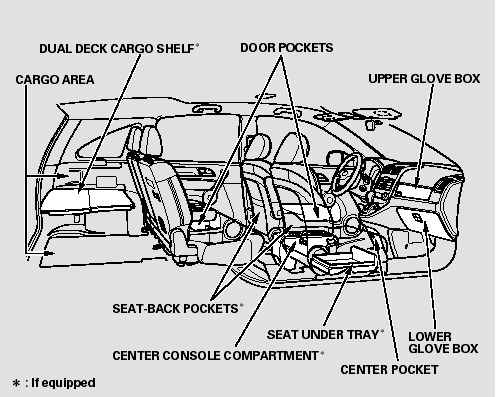Honda CR-V: Carrying Cargo
Honda CR-V (2006–2011) Owner's Manual / Before Driving / Carrying Cargo

Your vehicle has several convenient storage areas:
Lower glove box
Upper glove box
Console compartment
Door pockets
Seat-back pockets
Seat-under tray (if equipped)
Center pocket
Cargo area, including the rear seats when folded up or down.
Upper and lower cargo areas with the dual deck cargo shelf (if equipped)
Roof-rack (if equipped)
However, carrying too much cargo, or improperly storing it, can affect your vehicle’s handling, stability, stopping distance, and tires, and make it unsafe. Before carrying any type of cargo, be sure to read the following pages.
- Load Limits
- Carrying Cargo in the Passenger Compartment
- Carrying Cargo in the Cargo Area or on a Roof Rack
- Carrying Cargo on the Dual Deck Cargo Shelf
- Optional Separation Net
- Cargo Hooks
READ NEXT:
 Load Limits
Load Limits
The maximum load for your vehicle
is 850 lbs (385 kg) for U.S. vehicles,
and 395 kg for Canadian vehicles.
This figure includes the total weight
of all occupants, cargo, and
accessories, and
 Carrying Cargo in the Passenger Compartment
Carrying Cargo in the Passenger Compartment
Store or secure all items that could
be thrown around and hurt
someone during a crash.
Be sure items placed on the floor
behind the front seats cannot roll
underneath and interfere with the
 Carrying Cargo in the Cargo Area or on a Roof Rack
Carrying Cargo in the Cargo Area or on a Roof Rack
Distribute cargo evenly on the
floor of the cargo area, placing the
heaviest items on the bottom and
as far forward as possible. Tie
down items that could be thrown
about the vehicle during
SEE MORE:
 Side Engine Mount Replacement
Side Engine Mount Replacement
1. Support the engine with a jack and wood block
under the oil pan.
2. Remove the power steering (P/S) fluid reservoir
from the holder.
3. Remove the upper torque rod.
4. Remove the ground cable (A), then remove the side
engine mount bracket (B).
5. Remove the side engine mount stiffener (A), th
 Rear Window Wiper and Washer
Rear Window Wiper and Washer
1. OFF
When you turn the wiper switch to
the ‘‘OFF’’ position, the wiper will
return to its parked position.
2. Rotate the switch clockwise to
turn the rear window wiper ON.
The wiper operates every 7
seconds after completing two
sweeps.
3. Hold past ON to activate the rea
© 2016-2025 Copyright www.hcrv.net

